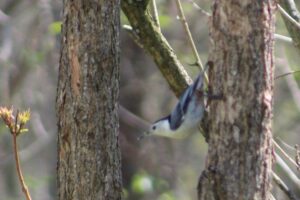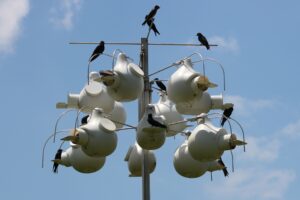By volunteer

Bernheim has provided thoughtful stewardship of more than its 16,000 acres, and provides excellent habit for more than 200 bird species that visit or nest here annually. The locations listed below are great places for birding, with or without binoculars.
The Canopy Tree Walk
When this area is not closed due to COVID-19, the Canopy Tree Walk, which perches 75 feet above the forest floor, can give you a bird’s eye view of those songsters that prefer hanging out in the treetops. Black-throated Blue and Cerulean Warblers, Red-eyed Vireos, Warbling Vireos, Summer Tanagers, and Yellow-billed Cuckoos are some of the possible eye-to-eye encounters from this lofty perch

Elm Lick, Iron Ore, Cull Hollow, Bent Twig, and Poplar Flat trails
These trails provide the deep woods habitat where you may encounter the haunting flute-like song of the Woodthrush, or the rollicking calls from Carolina Wrens and Kentucky Warblers. Many species of woodpeckers, including the Pileated Woodpecker can be seen and heard in our deep woods. You also may encounter Eastern Towhees raising a ruckus in the undergrowth, especially in heavily thicketed areas where they scratch and hop as they try to stir up invertebrate snacks from under leaves.
The Big Prairie
Watch for the Common Yellow-throat in the low wet grassy areas of the prairie. Their call has been described as a “witch-a –de- witch-a –de- witch”. Also look for the Eastern Kingbird, as they perch in the high bushes and noisily defend their territory. Field Sparrow and Song Sparrow, Indigo Buntings, Northern Bobwhite Quail, and many other birds are commonly seen in the Big Prairie.

Wilson Creek, the Olmsted Ponds, and Lake Nevin
If you see small fish, you may be lucky enough to observe a Belted Kingfisher perched on a branch fishing for dinner. If you wonder near patches of cattail around Lake Nevin, you may observe a male Redwing Blackbird flashing its brilliant orange and scarlet epaulets, as he proclaims his domain from atop cattail seed heads. The Olmsted ponds and Lake Nevin are great locations for Great Blue Herons, Green Herons, Mallards, Wood Ducks and other waterfowl. If you are lucky and observant, you many encounter Prothonotary and Hooded Warblers and many other warblers in the woods around Wilson Creek.

The Education Center Grounds and Wildlife Viewing Room
A surprising number of bird species can be seen or heard in the area between the parking lot and the Education Center. Brown Thrashers, Northern Mockingbirds, Gray Catbirds, Baltimore Orioles, Cedar Waxwings, Eastern Wood Peewees, and many more. When the Education Center is open, the Wildlife Viewing Room is a great place to watch the parade of common feeder birds, such as Blue Jays, White-breasted Nuthatches, Carolina Chickadees, American Goldfinches, Downy Woodpeckers, Northern Cardinals, Ruby-throated Hummingbirds, and many others. In early spring, the Purple Martins return from Brazil and set up housekeeping in the collection of gourd-shaped housing suspended on poles across from the Education Center parking lot. To see what life is like inside a Purple Martin nesting box, check out the link listed at the bottom of this post.

Bernheim’s Edible Garden
This garden provides food for people and for many other creatures including birds. American Goldfinch, Killdeer, Eastern Bluebirds, Great Crested Flycatchers, and a housing complex for the Purple Martins can all be observed in the Edible Garden, just across the street from the Visitor Center.
Observations and Questions to Ponder: The best way to learn about birds is to pay attention to them. What do you notice most when you look at a bird? Is it the features that jump out at you, the color, shape, size, markings, the way it moves, or the ear catching song, or call that grab your attention? Observation leads to curiosity. You may find yourself wondering about that bird’s life – perhaps what it eats, where it nests, or if it’s a yearlong resident of your location. Do particular birds remind you of early avian encounters? What are your best bird memories? Maybe you are making them now.
If you would like to know more about how to find Birds at Bernheim check out this excellent blog post by Volunteer Naturalist, Jim Scout.
At Home Activities:
To attract birds to your yard or neighborhood, provide them with food, shelter and water. For some helpful hints, see below for some of the many excellent resources to help you.
Let birding be a part of your morning routine. Find a place where you can begin watching observing, listening, and perhaps documenting them in the early part of your day.
Links to Learn More:
How to Create a Bird Friendly Yard
Volunteer Naturalist, Jim Scout shows how Purple Martins are a lot like us
Life inside a Purple Martin condominium
Bernheim’s Bird Research
